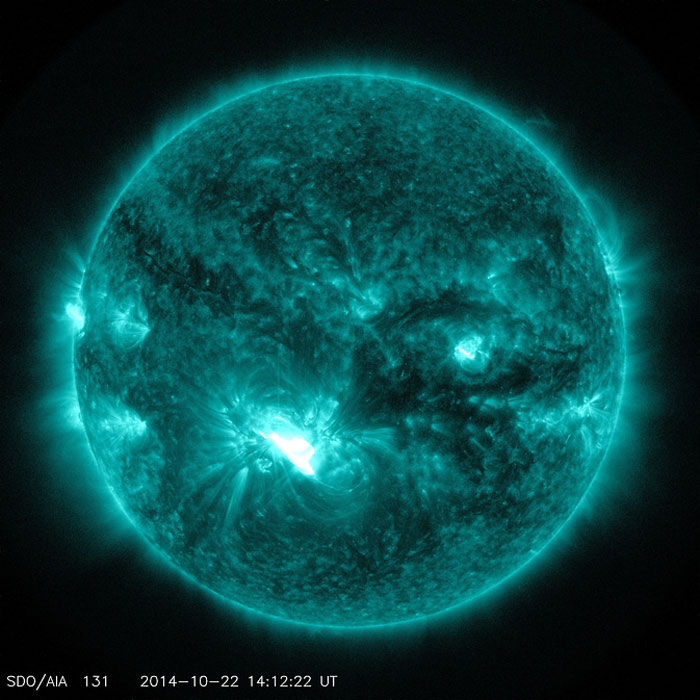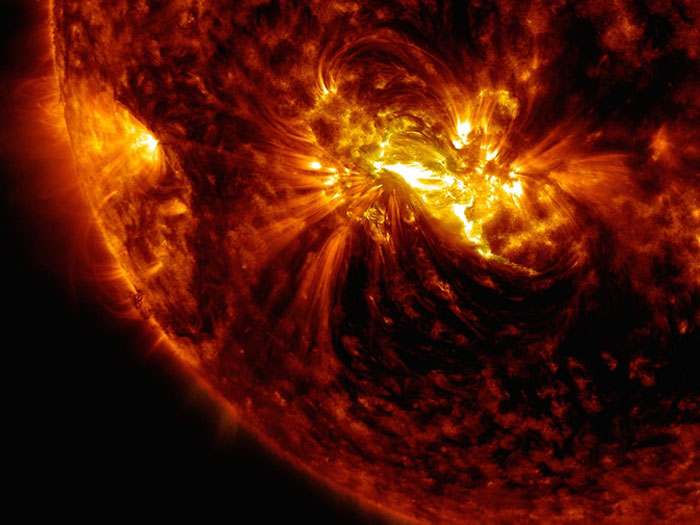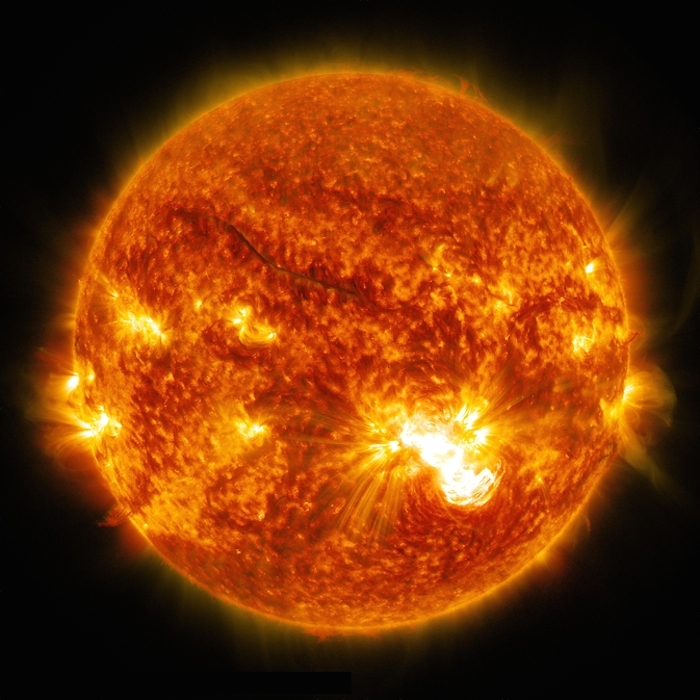.
23.10.2014
Update, 11:42 a.m. EDT: The sun erupted with another significant flare today, peaking at 10:28 a.m. EDT on Oct. 22, 2014. NASA’s Solar Dynamics Observatory captured images of the event, which occurred in the lower half of the sun. This flare is classified as an X1.6 class flare. X-class flares denote the most extreme flares. This is the third substantial flare from the same region of the sun since Oct. 19.
.

An X1.6 class flare erupted from the lower half of the sun, as seen in the bright flash of light in this image from NASA's SDO. This image shows extreme ultraviolet light with a wavelength of 131 Angstroms, which highlights the intense heat of a solar flare and which is typically colorized in teal.
Image Credit: NASA/SDO
.
To see how this event may affect Earth, please visit NOAA's Space Weather Prediction Center at http://spaceweather.gov, the U.S. government's official source for space weather forecasts, alerts, watches and warnings.
Second Substantial Flare in Two Days - First Update: Oct. 22, 2014, 9:45 a.m. EDT
The sun emitted a mid-level solar flare, peaking at 9:59 p.m. EDT on Oct. 21, 2014. NASA's Solar Dynamics Observatory, which is always observing the sun, captured an image of the event. The same active region previously emitted an X1.1 solar flare on Oct. 19. Solar flares are powerful bursts of radiation. Harmful radiation from a flare cannot pass through Earth's atmosphere to physically affect humans on the ground, however -- when intense enough -- they can disturb the atmosphere in the layer where GPS and communications signals travel.
.

An active region on the sun erupted with a mid-level flare, an M8.7 class, on Oct. 21, 2014, as seen in the bright light of this image captured by NASA's Solar Dynamics Observatory. This image shows extreme ultraviolet light that highlights the hot solar material in the sun's atmosphere.
Image Credit: NASA/SDO
.
To see how this event may affect Earth, please visit NOAA's Space Weather Prediction Center at http://spaceweather.gov, the U.S. government's official source for space weather forecasts, alerts, watches and warnings.
This flare is classified as an M 8.7-class flare.
M-class denotes flares that are a tenth as strong as X-class flares, which are the most intense flares. The number provides more information about its strength. An M2 is twice as intense as an M1, an M3 is three times as intense, etc.
Updates will be provided as needed.
Quelle: NASA
.
Update: 25.10.2014
.
One Giant Sunspot, 5 Substantial Flares
October 25, 2014
On Oct. 25, 2014, the sun emitted its fifth substantial flare since Oct.19. This flare was classified as an X1-class flare and it peaked at 1:08 p.m. EDT.
.

An X-class flare erupted from the sun on Oct. 25, 2014, as seen as a bright flash of light in this image from NASA's SDO. The image shows extreme ultraviolet light in the 131-angstrom wavelength, which highlights the intensely hot material in a flare and which is typically colorized in teal.
Image Credit: NASA/SDO
.
To see how this event may affect Earth, please visit NOAA's Space Weather Prediction Center at http://spaceweather.gov, the U.S. government's official source for space weather forecasts, alerts, watches and warnings.
First Update: Oct. 24, 2014, 8:46 p.m. EDT
The sun emitted a significant solar flare, peaking at 5:41 p.m. EDT on Oct. 24, 2014. NASA's Solar Dynamics Observatory, which watches the sun constantly, captured images of the event. Solar flares are powerful bursts of radiation. Harmful radiation from a flare cannot pass through Earth's atmosphere to physically affect humans on the ground, however -- when intense enough -- they can disturb the atmosphere in the layer where GPS and communications signals travel.
To see how this event may affect Earth, please visit NOAA's Space Weather Prediction Center at http://spaceweather.gov, the U.S. government's official source for space weather forecasts, alerts, watches and warnings.
.

An X3.1-class flare erupted from the lower half of the sun on Oct. 24, 2014. This image of the flare was captured by NASA's SDO and it shows extreme ultraviolet light at wavelengths of 171 and 304 angstroms.
Image Credit: NASA/SDO
.
This flare is classified as an X3.1-class flare.
X-class denotes the most intense flares, while the number provides more information about its strength. An X2 is twice as intense as an X1, an X3 is three times as intense, etc.
The flare erupted from a particularly large active region -- labeled AR 12192 -- on the sun that is the largest in 24 years. This is the fourth substantial flare from this active region since Oct. 19.
4616 Views
